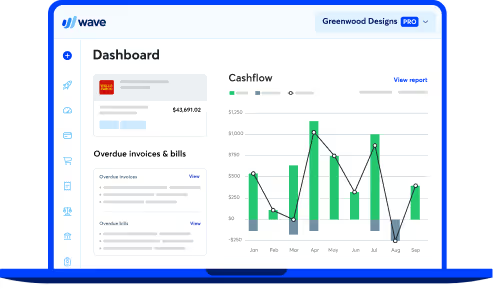
Building an onboarding process for your new employee or contractor
Now that you know when it’s time to hire a contractor or employee, and how to find one to help you grow your business, the next natural step is to get them set up on your team.
The hiring process doesn’t end when you extend a job offer. You’ll need to create an onboarding process to help your new team member transition into their new role. Not only does a smooth onboarding process increase the likelihood that your employee can contribute positively to your bottom line faster, but you’re also setting both of you up for success.
New employees, even experienced ones, need a little time to get up to speed. Data shows that it can take up to five months even for a full-time employee to become fully productive.
And while onboarding and training a new employee costs you a little time and effort, skipping this process can cost you significant time and money. According to Investopedia, an employee paid $8 per hour can cost a business around $3,500 in turnover costs. So, it’s in a business owner’s best interests to invest in the success of all employees—even contractors.
What is an onboarding process?
When you onboard a new employee, first and foremost, you’re introducing them to your business. By cultivating a great onboarding process, you’re establishing a solid first impression; and we all know that first impressions can make or break new relationships, especially in the business world.
To get new employees up to speed, you can either build an informal process—a loose list of new-hire activities—or something more formal, like a full onboarding program that walks new employees through multiple aspects of your company and their new position.
Regardless of which type of onboarding process you choose, there are a few tasks you’ll need to cross off your to-do list to ensure your new employee has everything they need to get started.
Onboarding: Before the first day
Yes, the onboarding process should start even before your new team member’s first official day of work.
While it may seem like overkill at first, you can get a few things prepped early to make their first days and months more seamless. It will also help you ensure that your payroll process is running smoothly and efficiently, so that your new hire gets properly paid after their first few weeks.
Prep their new hire paperwork
To get your new hire up and running—and make sure you’re compliant with government regulations—you’ll want to get the paperwork done right away. This paperwork is essential for getting employees set up properly on your small business's payroll, benefits, workers' comp, and other administrative areas.
For regular employees, Canadian businesses will need to record their new employee’s Social Insurance Number and get them to complete a Form TD1 to keep in your records. For U.S. businesses, you’ll need to record a new employee’s Social Security Number and have a completed W-4 and I-9 on file. For some states, you will be required to report a new hire to the state department.
While contractors aren’t technically permanent employees, there are a few necessary forms you and your worker will need to complete.
For U.S.-based businesses and workers, you’ll need to keep on file a Form W-9 for any contractors you pay $600 or more in a single year. This form requires having the contractor’s taxpayer ID number, name, and contact information. From there, you’ll have the info you’ll need to create a 1099-NEC form for your contractor for the tax year.
For Canadian businesses, you’ll need to file a T4A slip for any contractors you pay more than $500 in a year.
Using a tool like SimpleForms or BambooHR, you can send your new employee their official job offer, employment contract, and new hire paperwork digitally. They can return the signed forms prior to starting work to eliminate the tedious task of reviewing paperwork on their first day.
Create accounts and provide access to tools
To make it easier for new people to jump right in, figure out what tools they’ll need to do their job. Whether it’s simply setting up a company email address or creating accounts for software relevant to their job duties, try to complete all this prep work prior to their first day on the job.
Getting ahead of the game by granting them access to the tools they need means they can dive into their role day one, instead of spending precious time engrossed in setting up systems..
Create process documents for them to reference
If there are some processes your employee will complete regularly, create some process documentation to walk them through it.
Process docs can ease a new hire’s anxieties, especially during those first days on the job. This is especially true when a new employee is completing any kind of technical work. Not only do process docs cut down on training time (which helps you reclaim some of your own time), but employees can refer back to these docs if they have any questions in the future.
For example, if you’re hiring a blog manager, consider documenting how to complete common tasks in your blog’s content management system. Include relevant information such as required photo specifications and any other guidelines they should follow.
Put these docs in a shared folder so it’s easy for your new hire to access them whenever necessary.
If you need a little guidance to compile the process docs relevant to your new hire’s job, QuickBase offers a thorough walkthrough to help you create top-notch process documentation.
Onboarding: The first day and week
It’s the official starting date for your new hire!
Whether they’ll be working alongside you in an office or remotely, the first day and week will go more smoothly if you have a few additional things prepared.
Line up their first few projects
Since your employee will be fresh on the job, they’ll need a little guidance on their first few projects.
Create a list of assignments with brief explanations for each. Outline the expectations, dependencies, deliverables, and any soft or hard deadlines.
It’s also helpful to schedule a check-in meeting with your new employee ahead of their first few deadlines to answer any questions and ensure they’re on the right track.
Set up your first one-on-one meeting
Sometime during their first week, you’ll want to host your first meeting with them. In this meeting, you’ll walk them through your expectations for their work and the role.
You’ll want to establish success metrics (what does success look like for this role?), as well as short-term and long-term goals. Go over their job description and break down their responsibilities into daily, weekly, and monthly tasks to establish clear expectations for their workflow.
You can also remind your new hire of employee benefits, such as tools and flex funds, that can help them improve their quality of life both inside and outside of work.
Create and start a training schedule
While their first week will be crammed with settling into their new role, your new hire will likely need some training to effectively do their job. Even seasoned pros need context into how you complete work in your particular business.
To help them get up to speed without getting overwhelmed, create a training schedule. Depending on their pre-existing expertise, build a customized training program to guide them through the tools they’ll use, any relevant work processes, and the ins and outs of your business.
One schedule we suggest is training your new hire on a specific task or tool in the morning, then allowing them the afternoons during their first week to settle in and start their first projects.
Onboarding: The first month
Schedule your first check-in
The first month as a new employee is often the most difficult. It’s still early in the learning process, so their confidence may not be at its peak yet.
More than 20% of new hires leave within the first 45 days of starting a position, so addressing any issues early on can help retain the new person you’ve worked hard to hire and train.
To reassure them and offer them the chance to ask any questions, schedule an informal check-in meeting. Ask them how they’re feeling about the workload and the role in general. Are they comfortable and able to meet their deadlines?
Building a streamlined onboarding process
Now that you have a better handle on building an onboarding process for your new employee, you’ll have a defined roadmap to help your employee transition into their role.
And while creating a tailored onboarding process requires more of your time and effort, setting your employee up for success ensures they can help bolster your bottom line faster.
(and create unique links with checkouts)
*While subscribed to Wave’s Pro Plan, get 2.9% + $0 (Visa, Mastercard, Discover) and 3.4% + $0 (Amex) per transaction for the first 10 transactions of each month of your subscription, then 2.9% + $0.60 (Visa, Mastercard, Discover) and 3.4% + $0.60 (Amex) per transaction. Discover processing is only available to US customers. See full terms and conditions for the US and Canada. See Wave’s Terms of Service for more information.
The information and tips shared on this blog are meant to be used as learning and personal development tools as you launch, run and grow your business. While a good place to start, these articles should not take the place of personalized advice from professionals. As our lawyers would say: “All content on Wave’s blog is intended for informational purposes only. It should not be considered legal or financial advice.” Additionally, Wave is the legal copyright holder of all materials on the blog, and others cannot re-use or publish it without our written consent.


























